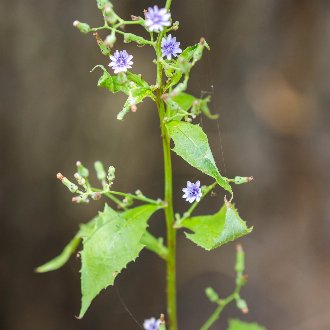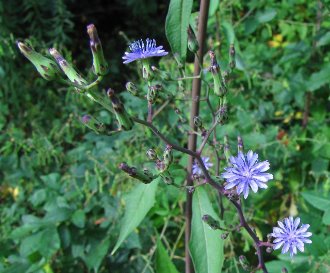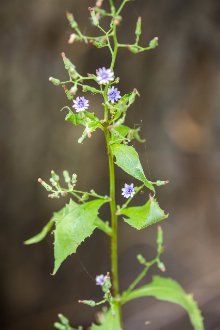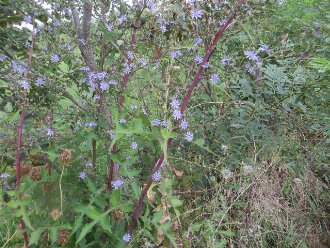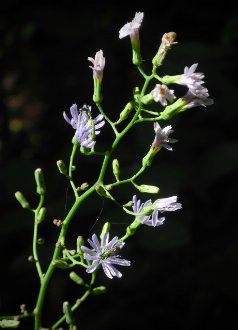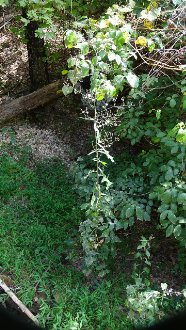Woodland Lettuce (Lactuca floridana (L.) Gaertn.)
Also known as Florida lettuce, Florida blue lettuce, false lettuce.
↑Summary
A tall biennial native to the southeastern to central US.
↑Range - Expand
| Legend | Color |
| Native or Not Present | |
| Native |
This tentative map is based on our own research. It may have limited data on Canada and/or Mexico, and there is some subjectivity in our assignment of plants as introduced vs. expanded. Read more in this blog post.
Although this plant occurs somewhere in each of these regions, it may only occur in a small part of some or all of them.
↑Similar Plants
↑Habitat
Found in a wide range of disturbed wooded to partly-wooded habitats, including well-drained sites in floodplain forests, and moister sites in mesic to dry-mesic upland forests, sometimes in savannas especially in the west of its range. Prefers fertile soils high in organic matter, moist conditions, and a narrow range of neutral to slightly acidic pH (6.5-7), but can tolerate drier conditions in parts of its range. Prefers sites that are mostly shaded but receive between 2-6 hours of direct sunlight. Often found in small gaps or clearings, or somewhat offset from edges and larger gaps. Also found in anthropogenic habitats such as moist, partly-wooded roadside ditches, and small forest fragments.
Becomes scattered and uncommon in the coastal plain, probably due to the greater prevalence of acidic soils; in this region it can be found locally on calcareous soils, including those formed on oyster shells. Some scattered, isolated populations also exist far north and west of the areas in which it is common.
This tends to be the most shade-tolerant of the Lactuca species in most of its range.
Usually found in habitats with some degree of disturbance, but lighter or less severe disturbance than other Lactuca species. This species has tended to benefit from humans as humans increase the disturbance in woodland areas, and tend to create more edge habitat that favors it.
↑Life Cycle
This species grows as an annual or biennial. It is more likely to grow as an annual in the north of its range, but plants are opportunistic, with some populations containing plants growing as annuals and others as biennials. Rarely, usually triggered by adverse conditions such as herbivory or top-kill, plants overwinter more than one winter as a rosette before flowering in a subsequent year.
Plants often germinate in spring after a period of dormancy, but seeds may germinate immediately upon seedfall, establish a basal rosette of leaves, and then overwinter. Some basal leaves will be evergreen in mild winters.
When plants bolt, they grow upright rapidly and typically increase greatly in size and extent. This plant is well-adapted to compete with other herbaceous vegetation during its bolting phase, but is less tolerant of herbaceous vegetation during its rosette phase.
↑Notes
We prefer the common name "woodland lettuce" because it is more descriptive, giving a fairly accurate reference to the habitats in which this species is found. The name "Florida lettuce" is somewhat misleading; although this species is native to Florida, it is not necessarily common there nor is it found in all parts of the state, and its range extends well into the Great Plains and north into Minnesota and Manitoba, far from Florida. The name "false lettuce" is misleading because, since all Lactuca species are referred to as "lettuces", the name implies that this species superficially resembles this genus but actually belongs elsewhere, which is not the case.
↑Links & External Resources
• Lactuca floridana (woodland lettuce) | USDA PLANTS Database (About This Site)
• Lactuca floridana (Lettuce) | Missouri Botanical Garden Plant Finder (About This Site)
• Lactuca floridana | Biota of North America Project (BONAP) (About This Site)
• Lactuca floridana | NatureServe Explorer (About This Site)
• Lactuca floridana | Flora of North America (About This Site)
• Lactuca floridana | Missouri Plants (About This Site)
• Woodland Lettuce | Maryland Biodiversity Project (About This Site)
• Lactuca floridana (L.) Gaertn. (Florida Blue Lettuce, Woodland Lettuce) | Digital Atlas of the Virginia Flora (About This Site)



